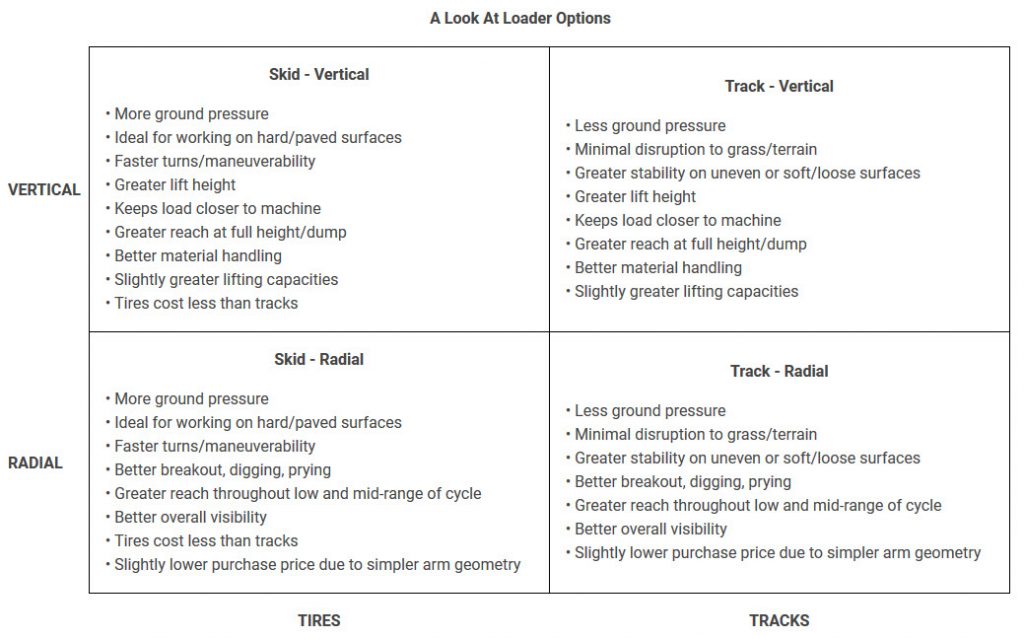
A compact track loader is one of the most versatile machines a contractor can own.
Whether as support equipment in a larger fleet or the main workhorse for an owner/operator, a skid steer and compact track loader are two of the most versatile machines a contractor can own. But what is the right loader arm and platform for each application? Contractors can follow this quick guide to set them on the right path.
- Loader arm – radial or vertical: Radial lift machines are best served for ground-engaging applications as they feature better breakout, digging and prying forces. As the travel path is most similar to an arc, this configuration provides greater reach at mid-ranges, which makes it ideal for loading and unloading off of smaller vehicles or platforms, such as pickup trucks. Visibility also tends to be a bit better with radial configurations. Vertical lift machines generally offer greater lifting heights, greater reach at full height and slightly higher lifting capacities. The arm design keeps the load closer to the cab for added stability and capacity. The arm design also allows for more stable material handling.
- Platform – tyres versus tracks: Tracked machines provide an incredibly stable platform that improves everything from grading to attachment use. The primary advantage is lower ground pressure and stable operation over uneven surfaces, as the tracks provide more contact with the ground than four independent tires. Tyred machines – the traditional skid steer loader – give the operator greater traction and maneuverability on paved surfaces. Tyred machines are quicker and have faster top travel speeds. Tyres are also more ideal in applications where tight turning is going to be taking place. While tyres will generally wear at a faster rate than tracks, tracks are more expensive to replace. Skid steers are typically less expensive than comparable compact track loaders.
- Lifting: Lifting is often the most taxing work that a skid steer or compact track loader will perform and its greatest measure of capacity. Case recommend selecting a machine with a rated operating capacity (50 percent of tipping load) that accounts for that heaviest common lifting task – and then some.
- The interaction between horsepower and rated operating capacity: Greater horsepower will typically allow for faster cycle times and make it possible for the machine to get to required pressures and flows faster – and maintain them more easily.
- Greater torque gives the operator more ability to power through resistance. It also aids in multifunctional performance and keeps the ground drive moving forward when it encounters resistance – all leading to greater, more powerful performance.
- A skid steer’s auxiliary hydraulic system provides the hydraulic flow that drives the machine’s attachments. The thing to remember is that not all attachments have the same hydraulic flow requirement. The most common system is the standard-flow auxiliary hydraulics package. Standard-flow auxiliary hydraulics are included on all skid steers from the factory and operate on the same pressure that the machine’s main hydraulics operate on. A standard-flow system powers many of the most common hydraulic attachments on the market, such as 4-in-1 buckets, hydraulic hammers, augers, trenchers and grapples. A high-flow auxiliary hydraulics system is a second option that further increases a skid steer’s versatility and productivity. A high-flow system can be factory-installed as an option or installed later in the field. It powers production-type attachments that require a high flow rate to perform as specified. Examples include cold planers, many snow blowers, rock saws, small mulchers, and chipper/shredders. When even more hydraulic power is required, an enhanced high-flow auxiliary hydraulics package is available. Examples of attachments that require an enhanced high-flow system include larger cold planers, larger mulchers used to clear brush and small trees, and a large rock saw you might find in an aggregates operation. Source